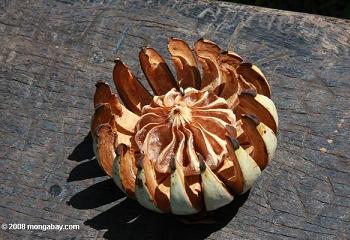The longstanding belief as to why some plants produce big seeds and others small seeds is that in this case bigger-is-better, since large seeds have a better chance of survival. However, Helene Muller-Landau, staff scientist at the Smithsonian Tropical Research Institute and head of the HSBC Climate Partnership’s effort to quantify carbon in tropical forests, grew dissatisfied with that explanation. For example, if big seeds were always the ‘right’ evolutionary path than why would any plants evolve small seeds? In a new paper in the Proceedings of the National Academy of Sciences, Muller-Landau argues for a more complex explanation involving a trade-off between surviving stressful conditions and taking full advantage when the conditions are just right.
“The standard explanation is that big seeds beat out small seeds everywhere that the big seeds arrive—but that just isn’t always the case,” she explains in a press release. “Big seeds don’t necessarily do any better than small seeds when conditions are good. Where big seeds really have the advantage is in stressful conditions like shade or drought—small seeds often can’t make it at all at stressful sites. In contrast, small-seeded species have an advantage at favorable sites, just because they’ve got more seeds in the game.”
 Seed pod from tropical forest in Suriname. Photo by: Rhett A. Butler. |
In other words, while a coconut palm seed may survive in both stressful and favorable conditions, the plant can only produce a limited number of seeds due to their size. Fig trees on the other hand produce innumerable tiny seeds. They risk losing all to most of their seeds in stressful conditions, yet the fig tree can take advantage of favorable conditions in a way a coconut palm never can.
“This simple, elegant theory, so well grounded in sound natural history, reminds me of the glory days of Robert MacArthur. It is a considerable advance in our understanding of the contrast between fugitive (“r”) and equilibrium (“K”) species and how they coexist,” Egbert Leigh, Smithsonian staff scientist, said commenting on the study.
“I love to figure out the reasons behind patterns I see in the forest,” said Muller-Landau. “The mathematical model I’ve developed explains why different plant species have different size seeds, and may also provide insight into the variation in offspring size and provisioning among animal species.”
Citation: Ref. The tolerance-fecundity trade-off and the maintenance of diversity in seed size. Helene C. Muller-Landau. PNAS Early Online Edition. www.pnas.org/cgi/doi/pnas.0911637107
Related articles
How tree communities respond to distance to edges and canopy openness
(12/06/2009) Tropical forests frequently experience the opening and closing of canopy gaps as part of their natural dynamics. When an edge is created, and the area outside the boundary is a disturbed or unnatural system, forests can be seriously affected even at some distance from the fragmented edge, since sunlight and wind penetrate to a much greater extent. This increases tree mortality and, consequently, canopy openness close to the edge. Thus, canopy openness can be both part of a natural gap-dynamics cycle and the direct manifestation of human edge effects.
Hunting across Southeast Asia weakens forests’ survival, An interview with Richard Corlett

(11/08/2009) A large flying fox eats a fruit ingesting its seeds. Flying over the tropical forests it eventually deposits the seeds at the base of another tree far from the first. One of these seeds takes root, sprouts, and in thirty years time a new tree waits for another flying fox to spread its speed. In the Southeast Asian tropics an astounding 80 percent of seeds are spread not by wind, but by animals: birds, bats, rodents, even elephants. But in a region where animals of all shapes and sizes are being wiped out by uncontrolled hunting and poaching—what will the forests of the future look like? This is the question that has long occupied Richard Corlett, professor of biological science at the National University of Singapore.
Plants recognize that family comes first
(10/16/2009) People like to say ‘blood is thicker than water’. But plants may actually treat ther siblings better than many of us: although lacking in blood, scientists have found that plants not only recognize family, but respect their space.